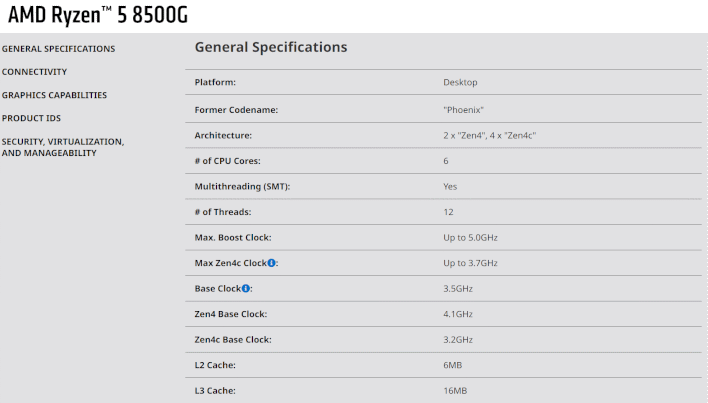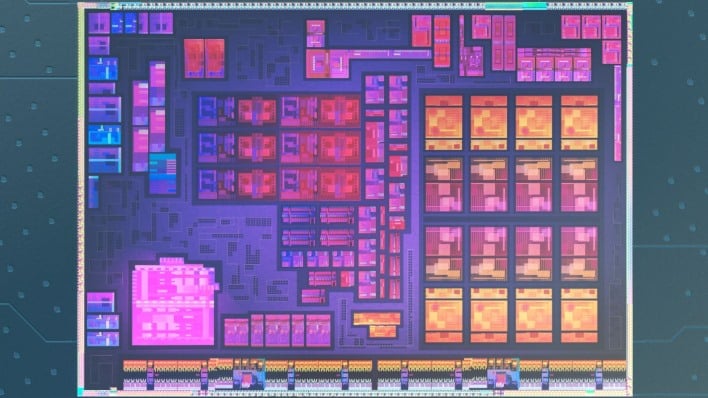AMD Reveals Zen 4c Clocks On Ryzen 5 8500G and Ryzen 3 8300G As Promised
When Intel started selling hybrid processors with two disparate types of cores, its beloved-by-enthusiasts ARK database was updated with the ability to display the core counts separately, and the clock rates of each core type. Given the company's emphasis on high efficiency, Intel's "E-cores" naturally don't clock as high as the "Performance cores" do.
AMD's Ryzen processors don't have "P-cores" and "E-cores" (yet), but the company has started to ship a slightly similar configuration where chips have a mix of standard "Zen 4" cores and then extra-dense "Zen 4c" cores. Unlike Intel's processors, the dense cores have the exact same capabilities as a standard Zen 4 core. However, given their density, they become less efficient at high clock rates because they heat up very quickly.

Obviously, you'd expect the Zen 4c cores to run lower clock rates than the Zen 4 cores, but when they were announced, AMD didn't clarify that in the specifications for these chips. We and other sites dinged AMD for this, because it's critical that customers know what to expect from a product they purchase. Now, the company has updated its own processor information database with those specifications, and to the surprise of no-one, Zen 4c does indeed run considerably lower clocks than Zen 4.
That's not a problem, to be clear; we're not exactly complaining that the Zen 4c cores are slower than Zen 4 cores—that's even arguably the point of them. On the Ryzen 5 8500G, the Zen 4c cores will clock as high as 3.7GHz, and have a base clock of 3.2GHz—still pretty decent given the high single-threaded performance of the Zen 4 architecture. The Ryzen 3 8300G, which only has a single Zen 4 core, will boost that core up to 4.9GHz, but the other three "Zen 4c" cores will only clock to 3.6GHz.

Both parts have a 2-WGP, 4-CU RDNA 3-based integrated GPU; that bit clocks to 2.6GHz on the 8300G, and 2.8GHz on the 8500G. If you want a faster integrated GPU, the Ryzen 5 8600G will have four RDNA 3 WGPs (8 CU), and the Ryzen 7 8700G will get the full six WGPs (12 CU) from "Phoenix." Those parts don't have "Zen 4c" cores, either.
While these specifications are nice to see, AMD doesn't list them for the AMD Ryzen Z1, which is based on the same "Phoenix 2" design as the Ryzen 5 8500G. That could be because it's meant for handhelds and AMD doesn't want to guarantee any particular clock rates—although it does give a base clock of 3.2GHz for this part.
Curiously, AMD still lists a nebulous "Base Clock" specification for these parts, with a pop-up indicator noting that this base clock value "reflects the average base frequency of all cores." We're not sure this value is useful to anyone, as it does not actually reflect the base clock rate of any of the processor's cores, but we suppose marketing departments want a number they can slap down in base/boost listings.
We are in general in favor of anything that allows customers to make informed decisions. Kudos to AMD for coming through on its promise to reveal these detailed specifications.
AMD's Ryzen processors don't have "P-cores" and "E-cores" (yet), but the company has started to ship a slightly similar configuration where chips have a mix of standard "Zen 4" cores and then extra-dense "Zen 4c" cores. Unlike Intel's processors, the dense cores have the exact same capabilities as a standard Zen 4 core. However, given their density, they become less efficient at high clock rates because they heat up very quickly.

Obviously, you'd expect the Zen 4c cores to run lower clock rates than the Zen 4 cores, but when they were announced, AMD didn't clarify that in the specifications for these chips. We and other sites dinged AMD for this, because it's critical that customers know what to expect from a product they purchase. Now, the company has updated its own processor information database with those specifications, and to the surprise of no-one, Zen 4c does indeed run considerably lower clocks than Zen 4.
That's not a problem, to be clear; we're not exactly complaining that the Zen 4c cores are slower than Zen 4 cores—that's even arguably the point of them. On the Ryzen 5 8500G, the Zen 4c cores will clock as high as 3.7GHz, and have a base clock of 3.2GHz—still pretty decent given the high single-threaded performance of the Zen 4 architecture. The Ryzen 3 8300G, which only has a single Zen 4 core, will boost that core up to 4.9GHz, but the other three "Zen 4c" cores will only clock to 3.6GHz.

Both parts have a 2-WGP, 4-CU RDNA 3-based integrated GPU; that bit clocks to 2.6GHz on the 8300G, and 2.8GHz on the 8500G. If you want a faster integrated GPU, the Ryzen 5 8600G will have four RDNA 3 WGPs (8 CU), and the Ryzen 7 8700G will get the full six WGPs (12 CU) from "Phoenix." Those parts don't have "Zen 4c" cores, either.
While these specifications are nice to see, AMD doesn't list them for the AMD Ryzen Z1, which is based on the same "Phoenix 2" design as the Ryzen 5 8500G. That could be because it's meant for handhelds and AMD doesn't want to guarantee any particular clock rates—although it does give a base clock of 3.2GHz for this part.
Curiously, AMD still lists a nebulous "Base Clock" specification for these parts, with a pop-up indicator noting that this base clock value "reflects the average base frequency of all cores." We're not sure this value is useful to anyone, as it does not actually reflect the base clock rate of any of the processor's cores, but we suppose marketing departments want a number they can slap down in base/boost listings.
We are in general in favor of anything that allows customers to make informed decisions. Kudos to AMD for coming through on its promise to reveal these detailed specifications.



